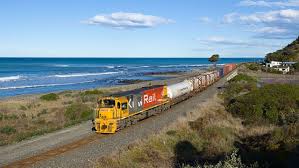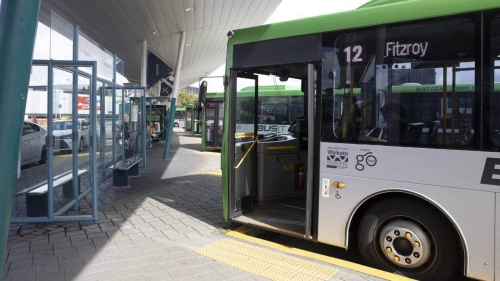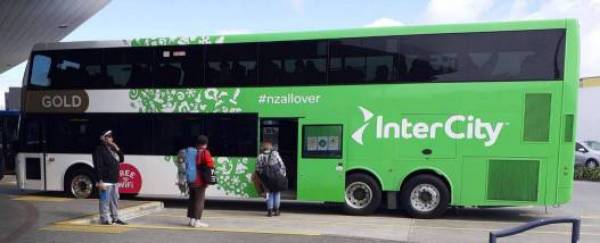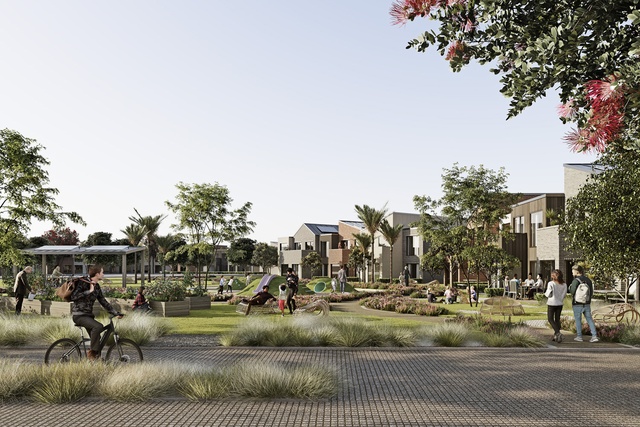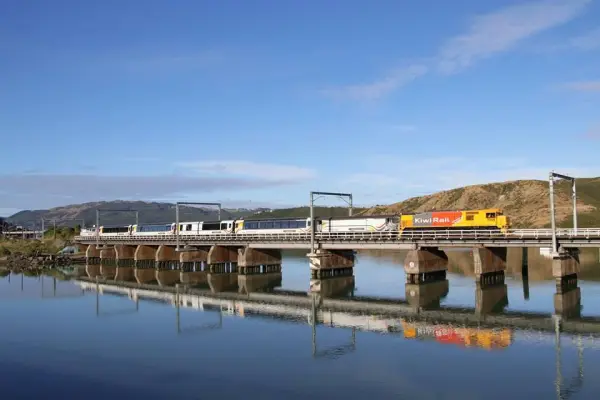Aotearoa New Zealand national rail network is an integral part of the country's national land transport network, with 3,898 kms of railway track of which 506 kms is electrified, linking most major and provincial cities, major towns, semi rural towns and small rural communities across the 14 (once the rail line between Napier and Gisborne is reconnected to the network) of the country's 16 local government regions, with connecting inter-island rail and road ferry services between the North and South Islands and a potential catchment of 80% of the country's population.
The national rail network operates as a 'closed access' predominantly single track freight rail network, operated by a government owned 'for profit' company – Kiwirail Holdings Ltd trading as 'Kiwirail', operating as the train, Cook Strait ferry and national rail infrastructure operator.
Currently, most of the rail traffic on the network is freight, excluding the metro passenger trains services in the Auckland and Wellington regions, heritage rail excursions, three 'limited stop' long distance 'scenic' passenger trains catering for domestic and international tourists and 2 inter-regional 'commuter' style passenger train services.
Background
From the early beginnings in 1863 to the rail network height in the 1950's, to the declines in freight and passenger traffic and restructuring in early 1980's and the privatisation and managed declined of the network in the 1990's until the government repurchased the network in 2008, has made the national rail network an under utilisied, national strategic asset.
With the recent Government's parliamentary Transport and Infrastructure Committee inquiry into the future of inter-regional passenger rail in Aotearoa New Zealand, raises the question, why can't the national rail network be the 'new' open access, environmentally friendly, national 'steel' highway network allowing greater utilisation of the network with increase freight and passenger train services through efficient signalling and increased track speeds.
What are the isssues
Currently, the operational and business model of the national rail operator - Kiwirail Holdings Ltd (Kiwirail), being both the train, ferry and the national rail infrastructure operator, acts as the gatekeeper of Aotearoa New Zealand national rail network, making it difficult for any other train operator whether they are heritage, domestic or international, to access the network to operate any commercialised 'for profit' freight and passenger train service/s, unless the government instructs the company to open the national rail network to external train operators.
If this happens, there could be a conflict of interest between 'Kiwirail' the train operator and 'Kiwirail' the rail infrastructure operator. Kiwirail Holdings Ltd business model is to make a profit which includes the rail infrastructure network, putting the rail infrastructure network as a 'for profit' operation, at odds with Aotearoa New Zealand's State Highway network which is 'not for profit' focused, unless the government instructs the company to operate the rail infrastructure network on a 'not for profit' cost recovery business model and train operations on a 'for profit' business model, splitting the company's operations into two 'business' entities, creating confusion to Kiwirail Holdings Ltd business model as a government owned company.
Kiwirail Holdings Ltd has made its business objectives clear in the company's national rail plan to government, that the company wants to be a predominantly rail freight and inter-island ferry operator and is not interested in re-establishing regional, inter-regional and long distance passenger 'Inter-City' passenger train services other than the current three 'scenic' passenger train services.
In 2020, the Government made change to the Land Transport Management Act where Kiwirail Holdings Ltd financial reporting is split into two categories being:
- 'above rail network' financial reporting that covers rail logistics services to freight markets, Ferry services for rail and road freight markets, passengers with private vehicles, passenger rail services for public transport (commuter) and tourism (Scenic) markets and property management, development for rail operations and third-party land use that funded through operating cash flows, external borrowings, shareholder investment programme to renew commercial assets to improve performance.
- 'below rail network' financial reporting that covers Infrastructure, core maintenance, renewals and improvements programme of the national rail network for all rail users that is funded by the Government through the Rail Network Investment Programme, track access agreements from all rail users including Kiwirail, with additional funding from New Zealand Transport Agency/Waka Kotahi land transport fund and any additional funding directly from the Government.
On the 9th October 2022, the Government announced to retain Kiwirail Holdings Ltd commercial business model as a State Owned Enterprise.
What is the future of the current network
The national rail network needs to be classified as a sustainable, environmentally friendly, national, strategic land transport infrastructure asset and be given the same planning and funding status as the State Highway network.
The previous government plan to move the country to zero emissions by 2050 and the increasing availability of sustainable environmentally friendly fuel options, increasing population growth coupled with improvements in train motive power technology, there has been calls over the years, more so recently, for the re-establishment of regular seven day per week, urban metro (Christchurch and Dunedin), regional, inter-regional and long distance 'Inter-City' passenger trains and increase rail freight services across the rail network to reduce the amount of trucks and non essential car use on the roads and the environmental and pollution emissions that are created.
Due to the managed decline of the national rail network over the years, major investment is required to upgrade the network's rail infrastructure, by removing any kinks in the network with deviations, double track where possible, increase passing loops, upgrading tunnels, strengthening bridges, complete the necessary electrification in the North Island, installing network wide high frequency signalling like ETCS 2 (European Train Control System Level 2) or equivalent and train control centres to allow for increase freight and passenger train movements and track speeds across the national rail network.
Revenue from the current operational and business model of Kiwirail Holdings Ltd, excluding metro passenger train services in the Auckland and the greater Wellington regions, does not cover the true maintenance and upgrade costs of the network, hence the company maintaining the national rail network to meet freight and limited passenger rail operations.
The previous government invested $434 million per year for the 2021-24 financial period, from the National Land Transport Fund to help in network maintenance.
What is the solution
The current operational and business model of Kiwirail Holdings Ltd being both the train, ferry and national rail infrastructure operator is not compatible to meet the government zero emissions by 2050.
It is time to reform the current national rail network by separating the current operational and business model into two entities - a national rail infrastructure entity and a train operation entity.
The new rail infrastructure entity would operate as a 'not for profit' strategic 'open access' national 'steel' highway network similar to the national State Highway network.
The entity would operate under the current New Zealand Railways Corporation, as all the land that existing, mothballed or abandoned track sits on, stations, etc are owned by the Corporation.
With an 'open access' rail network, it allows for the re-introduction of urban (Dunedin and Christchurch) regional and inter-regional passenger train services across the 13 regions, being the core of a national passenger transport network despite being 40% on public transport services.
As an 'open access' network, it will allow greater utilisation of the network, broken into the approximate percentages -
- urban, regional, inter-regional and long distance passenger rail - 30%
- Kiwirail and 3 'scenic' passenger rail services - 40%
- Heritage rail - 10%
- Other train operator/s that operates freight only (like Mainfreight Ltd), passenger only (night or long distance passenger rail) and/or passenger/freight - 20%
What is the New Zealand Railways Coporation
The New Zealand Railways Corporation was created in 1982 as a statutory corporation when the old New Zealand Railways Department was corporatised. In 1986, the Corporation became a state owned enterprise, required to make a profit, creating large job losses and reduction in operations, with the rail network, rail operations and ferry service of the Corporation being transferred to New Zealand Rail Limited in 1990.
Under a new proposed reform, the New Zealand Railways Corporation, which currently is a 'land holding' entity of approximately 18,000 ha of railway land, from which no financial return is expected, would take over the national rail network infrastructure and train control functions, as a 'paper' transaction, creating a new land holding and rail infrastructure entity, similar to ONTRACK that operated from 2004 to 2012.
The new land and rail infrastructure entity would own, maintain railway stations, etc in association with district and regional councils, goods yards, workshop buildings, track, tunnels, bridges, stations, signalling and train control.
The new and rail infrastructure entity revenue, would be from track access and train control fees, land/building rent, etc.
Kiwirail Holdings Ltd would become a train and ferry operator only, with the government holding at least 51% shareholding in the company to operate freight only or freight and passenger services as a 'for profit' business.
Who would run the Interislander ferry services
They could stay with Kiwirail Holdings Ltd or become a strategic state asset as a state-owned enterprise as it is Cook Strait crossing link for the State Highway and national rail networks.
For any reform to happen, would require cross political party support to reform the national rail network.
It is time to reform rail in Aotearoa New Zealand now, so lets do it
For further reading concerning the points raised in this discussion article -
- Time for a new regional passenger rail network
- Light Rail for Branch Lines
- Future of long distance passenger rail services in New Zealand
- CityConnect - the national public transport network
- Lets Connect Communities
- New Zealand's unified passenger transport strategy
The It is time to reform rail in New Zealand is Better Passenger Transport New Zealand initiative and supported by Public Transport Forum New Zealand.
If you support the government to reform and make the necessary investment to upgrade the national rail network into an 'open access', sustainable, environmentally friendly, strategic national 'steel' highway network, have your say or become proactive by getting involved in local better public transport campaign groups.
